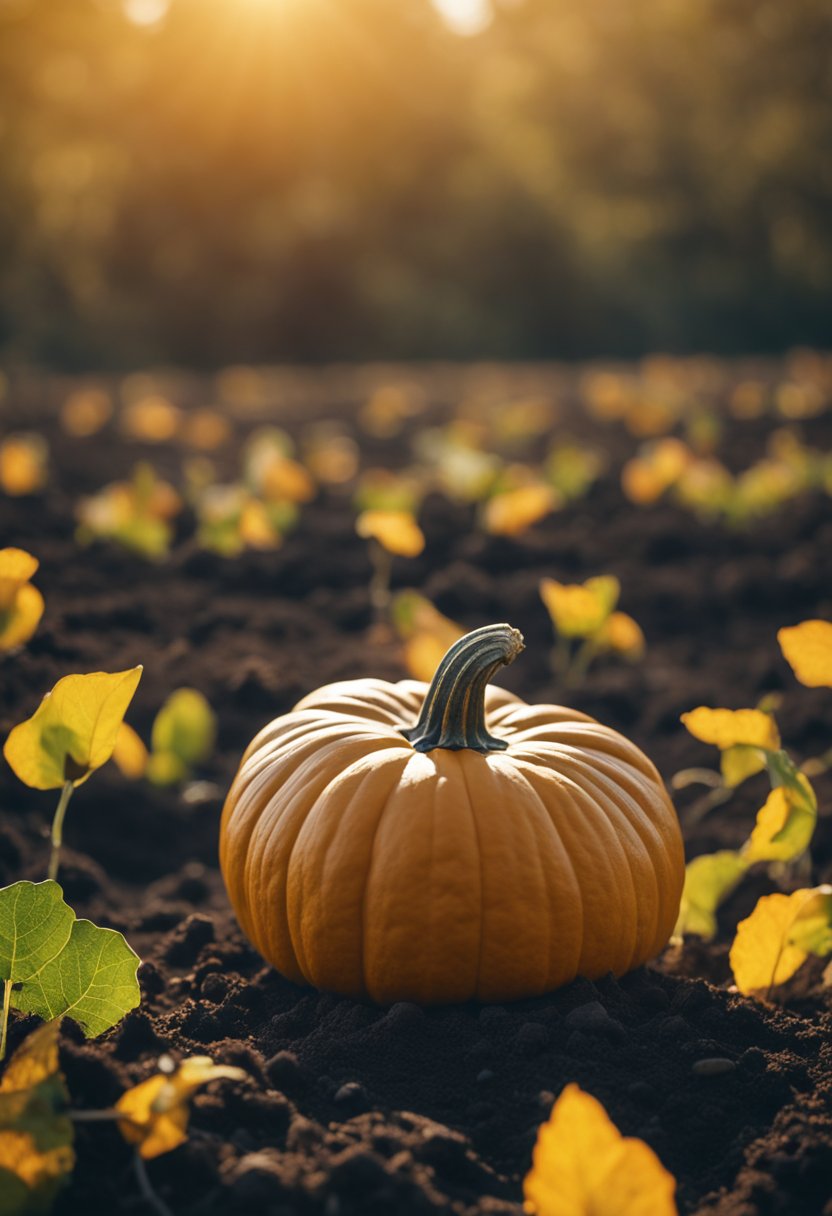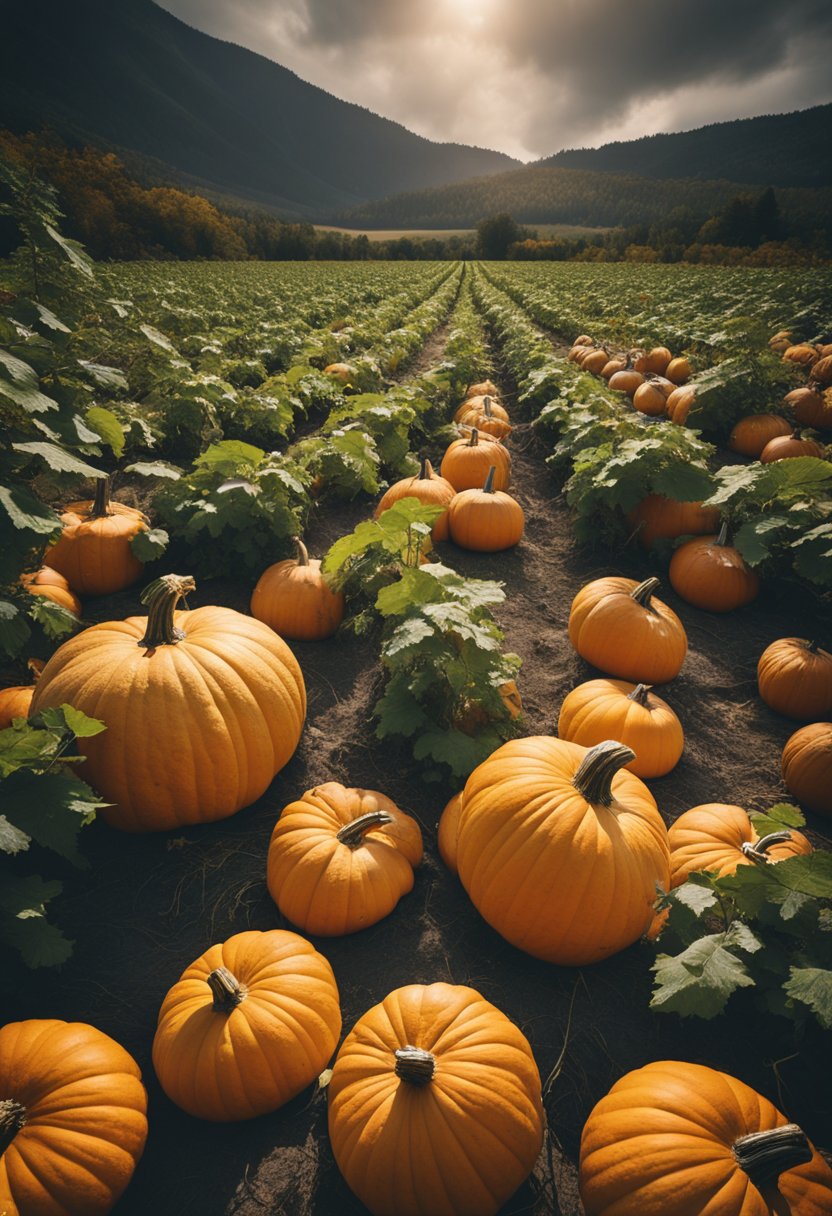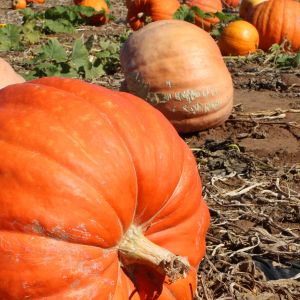Are you looking to grow a giant pumpkin that will be the talk of the town? Growing huge pumpkins is a fun and rewarding hobby that requires patience, dedication, and a little bit of know-how. With the right techniques, you can grow a pumpkin that weighs several hundred pounds and maybe even break a world record!
This post may contain affiliate links.
The first step to growing huge pumpkins is to choose the right variety. Look for seeds that are specifically bred for size and weight, such as the Atlantic Giant or the Big Max.
Once you have your seeds, it’s time to prepare the soil. Pumpkins need plenty of space to grow, so choose a spot in your garden that gets full sun and has well-draining soil. Add compost or other organic matter to the soil to help your pumpkin thrive.
Related Article: How to Make Pumpkin Butter
To encourage your pumpkin to grow as big as possible, you’ll need to provide it with plenty of water and nutrients. Regularly water your pumpkin, making sure to keep the soil moist but not waterlogged.
Fertilize your pumpkin with a balanced fertilizer every few weeks, and consider using a foliar spray to give it an extra boost. With the right care and attention, you’ll be well on your way to growing a huge pumpkin that will impress everyone who sees it.
Choosing the Right Seed

Growing huge pumpkins requires careful planning and preparation, starting with choosing the right seed. Here are some things to consider when selecting pumpkin seeds:
Understanding Pumpkin Varieties
There are many different varieties of pumpkins, each with its own unique characteristics. If you’re looking to grow a giant pumpkin, you’ll want to focus on varieties that are known for their size and weight.
Two popular varieties for giant pumpkins are the Atlantic Giant and Dill’s Atlantic Giant. Another variety to consider is the Big Max, which can also grow to be quite large.
When selecting a pumpkin variety, it’s important to consider your climate and growing conditions. Some varieties may be better suited for cooler or warmer climates, or for different soil types. Be sure to do your research and choose a variety that is well-suited to your specific growing conditions.

Sourcing Quality Seeds
Once you’ve decided on a pumpkin variety, it’s important to source high-quality seeds. Look for seeds that are fresh and have a high germination rate. You can purchase seeds from a variety of sources, including garden centers, seed catalogs, and online retailers.
When purchasing pumpkin seeds, be sure to check the seed packet for information on the variety, as well as planting and care instructions. Some seed packets may also include information on the expected size and weight of the mature pumpkin.
Related Article: Crock Pot Spiced Pumpkin Latte
In addition to purchasing seeds, you may also consider saving seeds from your own pumpkins for future planting. This can be a great way to ensure that you are growing pumpkins that are well-suited to your specific growing conditions.
By taking the time to choose the right type of seed and sourcing high-quality seeds, you can set yourself up for success when it comes to growing huge pumpkins.
Preparing the Soil
Before you start growing your pumpkins, it is important to prepare the soil properly. This will help ensure that your pumpkins grow to their full potential. Here are some things you can do to prepare your soil:
Soil Testing and Amendments
The first step in preparing your soil is to test it. You can buy a soil test kit from your local garden center or online. The test will tell you the pH level of your soil and what nutrients it is lacking. Once you know what your soil needs, you can amend it accordingly.
One of the best things you can add to your soil is compost. Compost is rich in nutrients and will help improve the soil structure. You can buy compost or make your own by composting kitchen scraps and yard waste.
Another great amendment is manure. Manure is high in nitrogen, which is essential for plant growth. However, make sure the manure is well-aged before adding it to your soil. Fresh manure can burn your plants.
Creating the Ideal Planting Bed
Once you have amended your soil, it’s time to create the ideal planting bed. Pumpkins need well-drained soil, so make sure your planting bed is not in a low-lying area where water can collect.
You also want to make sure the soil is warm enough for planting. Pumpkins need a soil temperature of at least 60°F (15.5°C) to germinate. You can check the soil temperature with a soil thermometer.
To create the ideal planting bed, follow these steps:
- Clear the area of any debris, rocks, or weeds.
- Dig a hole that is about 2 feet (60 cm) deep and 3 feet (90 cm) wide.
- Fill the hole with a mixture of compost, manure, and soil.
- Mix the amendments into the soil thoroughly.
- Smooth out the surface of the soil.
By following these steps, you will have a well-prepared planting bed that will give your pumpkins the best chance to grow to their full potential.
Planting and Germination
Sowing Pumpkin Seeds
To start growing huge pumpkins, you need to select the right seeds. Choose seeds from a reputable source, and look for varieties that are known to produce large pumpkins. Once you have your seeds, it’s time to sow them.
You can sow pumpkin seeds directly into the ground or start them indoors in peat pots. If you choose to sow them directly in the ground, wait until the soil temperature is at least 60°F. Plant the seeds 1 inch deep and 3 feet apart in rows.
If you prefer to start your seeds indoors, fill peat pots with a high-quality seed-starting mix. Place one seed in each pot, and water well. Keep the pots in a warm, sunny location, and water regularly to keep the soil moist.
Germination Conditions
Pumpkin seeds need warm, moist conditions to germinate. Keep the soil temperature between 75°F and 85°F, and make sure the soil stays moist but not waterlogged. If you’re starting your seeds indoors, cover the pots with plastic wrap to help retain moisture.
Once your seeds have germinated and the first true leaves have appeared, it’s time to transplant them into the garden. Make sure to harden off the seedlings by gradually exposing them to outdoor conditions before planting them in the ground.
Caring for Pumpkin Plants
Growing huge pumpkins requires proper care and attention to detail. Here are some tips on how to care for your pumpkin plants.
Watering and Fertilizing
Water and nutrients are essential for the growth and development of pumpkin plants. Make sure to water your pumpkin plants regularly, especially during hot and dry weather.
The soil should be moist but not waterlogged. Use a soaker hose or drip irrigation system to water your plants deeply and avoid wetting the foliage.
Fertilize your pumpkin plants with a balanced fertilizer that contains nitrogen, phosphorus, and potassium. Apply the fertilizer according to the package instructions and avoid over-fertilizing, as this can lead to excessive foliage growth and poor fruit development.
Pruning and Training Vines
Pumpkin plants produce both main and lateral vines. To encourage the growth of large pumpkins, it is important to train and prune the vines properly.
Allow only one or two main vines to grow per plant and remove any other lateral vines that emerge from the main vine. This will help the plant focus its energy on producing one or two large pumpkins.
Prune the main vine by removing any side shoots that emerge from the leaf axils. This will help improve air circulation and prevent the spread of diseases.
Protecting from Pests and Disease
Pumpkin plants are susceptible to a variety of pests and diseases, such as powdery mildew. To prevent these issues, keep the foliage dry by watering at the base of the plant and avoid wetting the leaves. Apply fungicides as needed to prevent powdery mildew and other fungal diseases.
Keep an eye out for pests such as squash bugs and cucumber beetles, which can damage the foliage and fruit. Use insecticides as needed to control these pests and prevent damage to your pumpkin plants.
Monitoring Growth and Health
Growing huge pumpkins requires careful monitoring of the plant’s growth and health. Here are some tips to help you keep track of your pumpkin’s progress and optimize its growth.
Tracking Progress
To monitor your pumpkin’s growth, it’s important to keep track of its size and weight over time. You can use a measuring tape to measure the circumference of the pumpkin at its widest point and record the measurement in a notebook or spreadsheet.
You should also weigh your pumpkin regularly and record the weight, as this will help you track its growth rate.
In addition to measuring the pumpkin itself, you should also pay attention to the leaves and vines. Healthy pumpkin plants should have large, green leaves and strong, sturdy vines.
If you notice any yellowing or wilting of the leaves, or if the vines start to look weak or spindly, it may be a sign that your pumpkin is not getting enough water or nutrients.
Optimizing Sunlight and Shade
Pumpkins need plenty of sunlight to grow, but they can also benefit from some shade during the hottest parts of the day. To optimize your pumpkin’s exposure to sunlight and shade, you can use a canopy of shade cloth to provide some relief from the sun’s rays.
When positioning your shade cloth, it’s important to make sure that it doesn’t block too much sunlight. Aim to provide around 30-50% shade, depending on the intensity of the sunlight in your area.
You should also make sure that the shade cloth is securely anchored to prevent it from blowing away in the wind.
By monitoring your pumpkin’s growth and optimizing its exposure to sunlight and shade, you can help ensure that it grows to its full potential. With a little bit of care and attention, you can grow a pumpkin that’s sure to impress!
Harvesting and Competing
Picking the Perfect Time to Harvest
When it comes to harvesting your giant pumpkin, timing is everything. You want to make sure your pumpkin has reached its full potential and is ready to be picked.
The best time to harvest your pumpkin is when it has reached its maximum size and has developed a deep, rich color. This usually occurs in late September or early October.
Before harvesting, make sure to cut back any remaining vines to prevent the pumpkin from continuing to grow. Use a sharp knife or pruning shears to cut the stem about 4 to 6 inches above the pumpkin. Be careful not to damage the pumpkin or its stem during the process.
Entering Giant Pumpkin Competitions
If you’re looking to compete with your giant pumpkin, there are plenty of opportunities to do so. State fairs and other competitions offer cash prizes and bragging rights for the biggest and best pumpkins.
Before entering a competition, make sure to carefully read the rules and regulations. Each competition may have different requirements for pumpkin size, weight, and appearance. Some competitions may even require a specific variety of pumpkin.
When preparing your pumpkin for competition, make sure to clean it thoroughly and remove any dirt or debris. You may also want to apply a coat of wax or vegetable oil to give it a shiny appearance.
Don’t forget to bring a scale to weigh your pumpkin and any necessary documentation to prove its authenticity.
Overall, harvesting and competing with giant pumpkins can be a fun and rewarding experience. With the right timing and preparation, you can grow a pumpkin that will impress judges and spectators alike.
Frequently Asked Questions
What are the best conditions for growing large pumpkins?
To grow large pumpkins, you need to ensure that they are planted in a spot with plenty of sunlight, good soil drainage, and ample space for the vines to spread.
The ideal temperature range for pumpkin growth is between 70 and 85 degrees Fahrenheit. Additionally, pumpkins thrive in soil that has a pH level between 6.0 and 6.8. You can test the pH of your soil with this inexpensive pH soil testing kit.
What type of fertilizer maximizes pumpkin growth?
Pumpkins require a lot of nutrients to grow, and a good fertilizer can help provide those nutrients. A balanced fertilizer with equal amounts of nitrogen, phosphorus, and potassium is best for pumpkin growth.
You can also use organic fertilizers, such as compost or manure, to help improve soil quality.
How can milk or sugar water affect pumpkin growth?
Milk and sugar water are both known to help promote pumpkin growth. Milk contains calcium, which can strengthen the cell walls of the pumpkin and make it more resistant to disease and pests.
Sugar water can help stimulate microbial activity in the soil, which can improve nutrient uptake by the pumpkin.
What are the secrets to nurturing a pumpkin over 2,000 pounds?
Growing a huge pumpkin over 2,000 pounds requires a lot of dedication and hard work. Some key tips include starting with a high-quality seed, providing plenty of water and nutrients, and carefully managing the pumpkin’s growth by pruning and training the vines.
You should also protect the pumpkin from pests and disease by using organic pest control methods and monitoring the plant closely.
How long does it typically take to grow a giant pumpkin?
Giant pumpkins can take anywhere from 90 to 120 days to reach full maturity, depending on the variety and growing conditions. It’s important to monitor the pumpkin’s growth carefully and harvest it at the right time to ensure that it reaches its maximum size.
Where can I find giant pumpkin seeds for planting?
There are many seed companies that specialize in giant pumpkin seeds, and you can also find them online or at your local gardening store. Look for seeds from reputable sources and be sure to choose a variety that is well-suited to your growing conditions.
Follow my gardening board on Pinterest.





